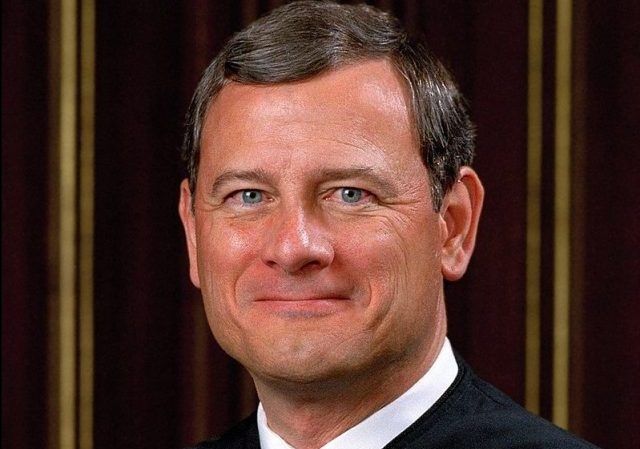SCOTUS: John Roberts Joins Liberals To Permit PA To Count Non-Postmarked Ballots 3-Days After Election Day

How important is the nomination of Amy Coney Barrett? I wrote on September 19, 2020, that it was important to fill the Ginsburg vacancy prior to Election Day in order to neutralize the unreliable vote of Chief Justice John Roberts:
Filling the vacancy now is protection against … John Roberts. From Obamacare to the recent religious liberty lockdown cases, the Chief Justice has shown himself to be unreliable and subject to pressure campaigns. Particularly when the 2020 election cases (which there will be) make their way to the Supreme Court, a rogue Roberts could result in a 4-4 deadlock, which means the appeals court decision stands. A 6-3 Supreme Court nullifies Rogue Roberts.
My point was just proven. Roberts joined the three liberals to reject a stay (in two cases, here and here) of a Pennsylvania Supreme Court Order that permits mail-in ballots to be counted if received three days after Election Day — even if the envelope has no postmark. That’s right, even if there is no postmark. Justices Thomas, Alito, Gorsuch, and Kavanaugh would have granted the stay.
The Petition for a Stay argued, in part:
The Pennsylvania Supreme Court majority acknowledged that there is “no ambiguity regarding the deadline set by the General Assembly”: to be counted, absentee and mail-in ballots “‘must be received in the office of the county board of elections no later than eight o’clock P.M. on the day of the primary or election.’” A.34 (quoting 25 Pa. Stat. § 3150.16(c)). Nonetheless, on a 4-3 vote, the majority ordered “a three-day extension” of that deadline for the imminent general election—and even imposed a remedy that creates a serious likelihood that election officials will count ballots that are cast or mailed after Election Day. A.63. Specifically, the majority required election officials to presume that any ballot received by its judicially extended deadline that lacks an intelligible postmark was “mailed by Election Day unless a preponderance of the evidence demonstrates that it was mailed after Election Day.” A.64. Thus, under the majority’s judicially created presumption, ballots without intelligible postmarks (hereinafter, “non-postmarked ballots”) will be counted even if they are cast or mailed after Election Day, except in the extraordinarily rare case where proof of the untimely casting or mailing can be adduced. See id….The majority’s judicial extension and non-postmarked ballots presumption are preempted by a trio of federal statutes that set a uniform nationwide federal Election Day. See 3 U.S.C. § 1, 2 U.S.C. §§ 1, 7. The majority, moreover, gave insufficient regard to—and, in fact, usurped—the General Assembly’s plenary authority to “direct [the] Manner” for appointing electors for President and Vice President, U.S. Const. art. II, § 1, cl. 2, and broad power to prescribe “[t]he Times, Places, and Manner” for congressional elections, id. art. I, § 4, cl. 1; Bush v. Palm Beach County Canvassing Bd., 531 U.S. 70, 77 (2000) (per curiam). As the three dissenting justices explained, the decision below is incompatible with the General Assembly’s “clear legislative intent” to ensure that “a timely vote could be cast before the only meaningful milestone [in the legislative scheme], Election Day.” A.87–88 (Donohue, J., concurring and dissenting); A.91 (Saylor, C.J., concurring and dissenting). And with courts around the country weighing similar extensions of received-by deadlines that could push voting past Election Day in numerous states, the issues presented are important, recurring, and in need of this Court’s immediate resolution.Applicant Republican Party of Pennsylvania (“RPP”) thus respectfully requests that the Court follow the rule it set forth earlier this year and enter a modest stay of the majority’s non-postmarked ballots presumption pending disposition of RPP’s forthcoming petition for a writ of certiorari….
Because the Supreme Court split 4-4, the PA Supreme Court order stands.
Axios gets the significance.
Why it matters: It’s a major win for Democrats that could decide the fate of thousands of ballots in a crucial swing state that President Trump won in 2016. The court’s decision may signal how it would deal with similar election-related litigation in other states.The state of play: A Pennsylvania Supreme Court decision moved the deadline for absentee ballots to be counted from 8 p.m. on Election Day to 5 p.m. the following Friday, Nov. 6. If the U.S. Supreme Court had granted a stay, it would have resulted in a return to the original deadline.The big picture: The deadlock underscores the importance for Republicans of confirming Trump’s Supreme Court nominee Amy Coney Barrett, who the president himself has said could be a deciding vote in an election-related dispute.
This is a prescription for conflict.
CLICK HERE FOR FULL VERSION OF THIS STORY